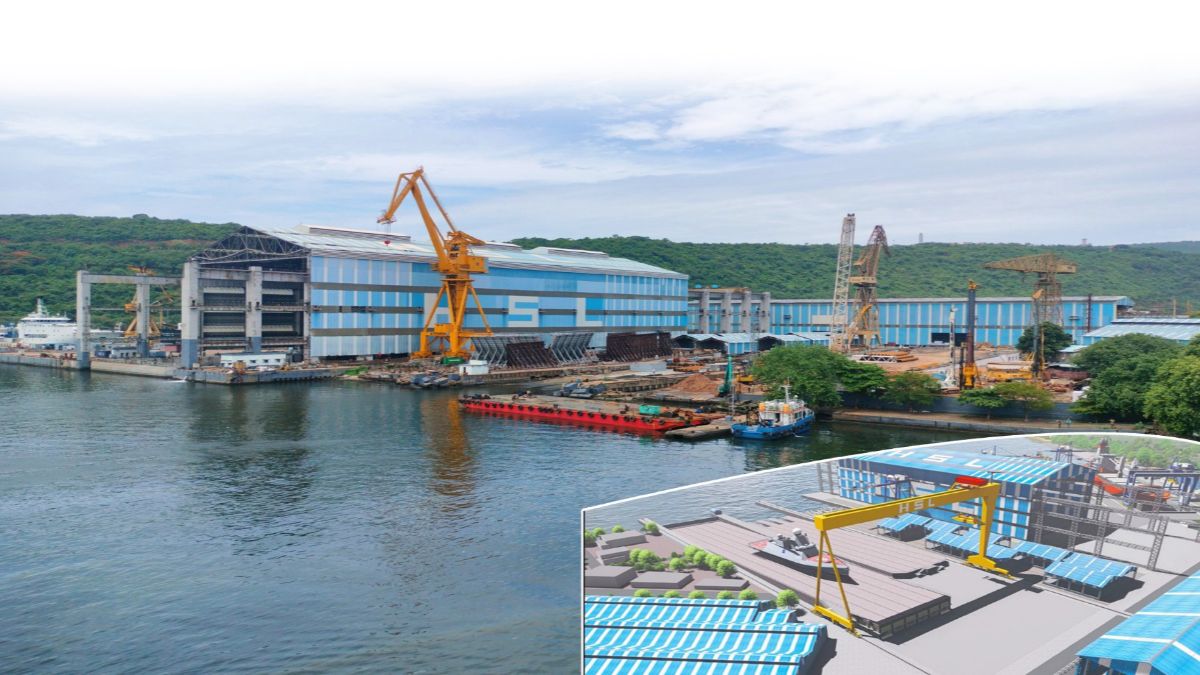Hindustan Shipyard Limited (HSL), once weighed down by financial losses and limited to India’s domestic naval contracts, is now charting a new course — toward the global maritime market.
In an exclusive interview with Firstpost, Commodore Hemant Khatri (Retd.), Chairman and Managing Director of HSL, confirmed that the state-run shipyard is actively preparing to enter the international export space, building on its recent financial revival and the completion of India’s first indigenously-built— and Asia’s most advanced— Diving Support Vessels (DSVs), Nistar.
Export of advanced DSVs
As India’s maiden indigenously-built DSV, Nistar is a critical naval asset for saving distressed submarines, conducting underwater repairs and recovery, and supporting friendly navies under India’s SAGAR (Security and Growth for All in the Region) initiative.
“HSL is now eyeing exports of Diving Support Vessels or any other vessel with dynamic positioning [DP] requirements, catering to both defence and offshore industries,” Cmde Khatri said.
Dynamic Positioning (DP) is a computer-controlled system that automatically maintains a vessel’s position and heading using its own propellers and thrusters. This is essential for operations where anchoring is not possible or safe—such as deep-sea diving, offshore drilling, or submarine rescue.
“HSL is also looking at making platform support vessels or offshore support and supply vessels which require DP2 capabilities,” Cmde Khatri said.
DP2, or Dynamic Positioning Class 2, refers to the second level of DP capability, offering higher accuracy and system redundancy. This means the vessel can continue to hold its position even if a single fault occurs in the system, such as a generator or thruster failure.
Impact Shorts
More ShortsCmde Khatri explained that “[DP2] has actually 4 thrusters and two shafts with Controllable Pitch Propeller [CPP].” CPPs allow fine-tuned thrust control without changing engine speed, making the vessel more responsive and fuel-efficient.
This DP2 system has been integrated into the DSV Nistar as well.
East coast MRO ambitions
In parallel with its export drive, HSL is laying the groundwork to establish a global Maintenance, Repair and Overhaul (MRO) hub on India’s eastern seaboard.
“HSL is already undertaking repairs of almost 15-20 ships in a year of all sizes, including a few foreign vessels,” Cmde Khatri told Firstpost. “We want to expand this — also looking at development of facilities on the east coast in consultation with the Andhra Pradesh government to take on big ships — the VLCCs [Very Large Crude Carriers], 300-meter Afromax, Panamax, etc. for refits as well as for construction.”
Such a facility could place Visakhapatnam and the east coast in direct competition with maritime repair hubs in Singapore and the Gulf region, particularly for large commercial and military vessels traversing the Indian Ocean Region.
“This will take a little time and development of infrastructure,” he acknowledged, “but it will facilitate large-scale employment to the youth, to the skilled workforce, and development of MSMEs so that the entire ecosystem in Vizag or in the east coast of Andhra Pradesh develops as a marine ecosystem and supports shipbuilding and ship repair.”
A financial comeback story
The plans come on the back of HSL’s remarkable financial rebound. After recording a negative net worth of Rs 1,023 crore in 2014-15 and navigating the shocks of the COVID-19 pandemic, the shipyard is now reporting a provisional profit before tax of Rs 295 crore for FY 2024-25. The achievement becomes even more remarkable in the light of the fact that HSL has achieved a positive net worth for the first time in over four decades.
The transformation, officials say, is the result of internal reforms, upgraded technology, and a strategic focus on high-complexity vessels.
The Nistar project, which achieved 80 per cent indigenous content through over 120 Indian MSMEs, reflects not only the vision of “Atmanirbhar Bharat” (Self-Reliant India) but also New Delhi’s ambition to position itself as a maritime power in the Indo-Pacific. It aligns with India’s SAGAR doctrine (Security and Growth for All in the Region), which envisions India as a net security provider in the Indian Ocean Region.
Rising global interest
As maritime security threats grow, so does the demand for advanced support and rescue platforms. Nations across Southeast Asia, Africa, and the Middle East are actively modernising their naval fleets and deepwater capabilities — a market HSL now hopes to tap.
With its upgraded facilities, a proven track record in delivering naval assets, and a pipeline of skilled Indian engineering talent, HSL is aiming to make for India, and make for the world.
Shreya Mundhra is a journalist with Firstost specialising in global economy, foreign affairs, defence and conflict coverage. She can be reached via email at shreya.mundhra@nw18.com
)